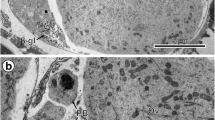Summary
The epiblast and the surface of the perigerminal yolk of the just laid quail blastoderm were examined by scanning electron microscopy (SEM). The dorsal surface structures are microvilli, mainly along the cell borders. The scarcity of the dimples does not support that ingression occurs at this stage. Flat or round cells on the epiblast are possibly deep layer cells that failed to incorporate after passing through the epiblast. The majority of the blastoderms have an irregular margin. The large edge cells possess microvilli at their borders only. A few blastoderms, probably the more developed, have a smooth edge with closely packed cells. The margin of these germs shows round cells and lamellae that could be protruded by deep cells. The process of cell rounding and extension of lamellae may be the onset of the formation of the margin of overgrowth. Concentric zones are present on the surface of the perigerminal yolk, on which microvilli and blebs are found near the germ. The presence of cell projections on the perigerminal surface suggests its living nature.
Similar content being viewed by others
References
Abercrombie M, Heaysman J, Pegrum SM (1971) the locomotion of fibroblasts in culture. IV. Electron microscopy of the leading lamella. Exp Cell Res 67:359–367
Anderson TF (1951) Techniques for the preservation of three-dimensional structure in preparing specimens for the electron microscope. Trans NY Acad Sci Ser II 13:130–140
Bakst MR (1978) Scanning electron microscopy of the vitelline membrane of the hen ovum. J Reprod Fert 52:361–364
Bancroft M, Bellairs R (1974) The onset of differentiation of the chick embryo (SEM and TEM). Cell Tissue Res 155:399–418
Bellairs R (1971) In: Developmental processes in higher vertebrates, Logos Press Ltd. London, p 366
Bellairs R, Boyde A, Heaysman JE (1969) The relationship between the edge of the chick blastoderm and the vitelline membrane. Wilhelm Roux's Arch 163:113–121
Bellairs R, Lorenz FW, Dunlap T (1978) Cleavage in the chick embryo. J Embryol Exp Morphol 43:55–69
Blount M (1909) The early development of the pigeon's egg, with special reference to polyspermy and the origin of the periblast nuclei. J Morphol 20:1–64
Chernoff EAG, Overton J (1979) Organization of the migrating chick epiblast edge: attachment sites, cytoskeleton and early developmental stages. Dev Biol 72:291–307
Downie JR (1974) Behavioural transformation in chick yolk sac cells. J Embryol Exp Morphol 31:599–610
Downie JR (1976) The mechanism of chick blastoderm expansion. J Embryol Exp Morphol 35:559–575
Downie JR, Pegrum SM (1971) Organization of the chick blastoderm edge. J Embryol Exp Morphol 26:623–635
Eyal-Giladi H, Kochav S (1976) From cleavage to primitive streak formation: a complementary table and a new look at the first stages of the development of the chick. I. General morphology. Dev Biol 49:321–337
Fargeix N (1964) La caille domestique (Coturnix coturnix japonica) Ponte et étude de l'oeuf non incubé. Arch Anat Histol Embryol (Stresh) 97:275–281
Hamburger V, Hamilton HI (1951) A series of normally stages in the development of the chick embryo. J Morphol 88:49–92
Hamilton H (1965) In: Lillie's development of the chick Holt, New York, pp 46–69
Hudspeth AJ (1982) The recovery of local transepithelial resistance following single-cell lesions. Exp Cell Res 138:331–342
Jacobson W (1938) The early development of the avian embryo. I. Endoderm formation. J Morphol 62:415–445
Kochav S, Ginsburg M, Eyal-Giladi H (1980) From cleavage to primitive streak formation: a complementary normal table and a new look at the first stages of the development of the chick. II. Microscopic anatomy and cell population dynamics. Dev Biol 79:269–308
Mehrbach H (1935) Beobachtungen an der Keimscheibe des Hühnchens vor dem Erscheinen des Primitivstreifens. Z Anatomie 104:635–652
New DAT (1959) The adhesive properties and expansion of the chick blastoderm. J Embryol Exp Morphol 7:146
Patterson JT (1909) Gastrulation in the pigeon's egg. A morphological and experimental study. J Morphol 20:45–123
Radice GP (1980) The spreading of epithelial cells during wound closure in Xenopus larvae. Dev Biol 76:26–46
Robertson M, Armstrong J, Armstrong P (1980) Adhesive and non-adhesive membrane domains of amphibian embryo cells
Trinkaus JP (1980) Formation of protrusions of the cell surface during tissue cell movement. In: Tumor cell surfaces and malignancy. Alan R Liss Inc New York, pp 887–906
Von Baer KE (1828) Ueber die Entwicklungsgeschichte der Thiere. Beobachtungen und Reflextion. I. Entwicklungsgeschichte des Hühnchens im Eie. Borntrager Königsberg, p 315
Weinberger C, Brick I (1982) Primary hypoblast development in the chick. I. Scanning electron microscopy of normal development. Wilhelm Roux's Arch 191:119–126
Author information
Authors and Affiliations
Rights and permissions
About this article
Cite this article
Andries, L., Vakaet, L. & Vanroelen, C. The dorsal surface of the animal pole of the just laid quail egg, studied with SEM. Anat Embryol 166, 135–147 (1983). https://doi.org/10.1007/BF00317949
Accepted:
Issue Date:
DOI: https://doi.org/10.1007/BF00317949




